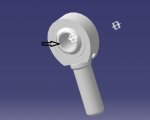Hi to all,
I need some help to constraint properly this spherical plain bearing to make it work. As It's obvious, I should get 3 rotational DOF for the sphere in respect of the rest of the mechanism. I've tried with the spherical joint but CATIA don't let me do the simulation because there are 3 free DOF (just what I need).
I don't know how to solve this, so if someone could help me I'll be grateful.
I need some help to constraint properly this spherical plain bearing to make it work. As It's obvious, I should get 3 rotational DOF for the sphere in respect of the rest of the mechanism. I've tried with the spherical joint but CATIA don't let me do the simulation because there are 3 free DOF (just what I need).
I don't know how to solve this, so if someone could help me I'll be grateful.





